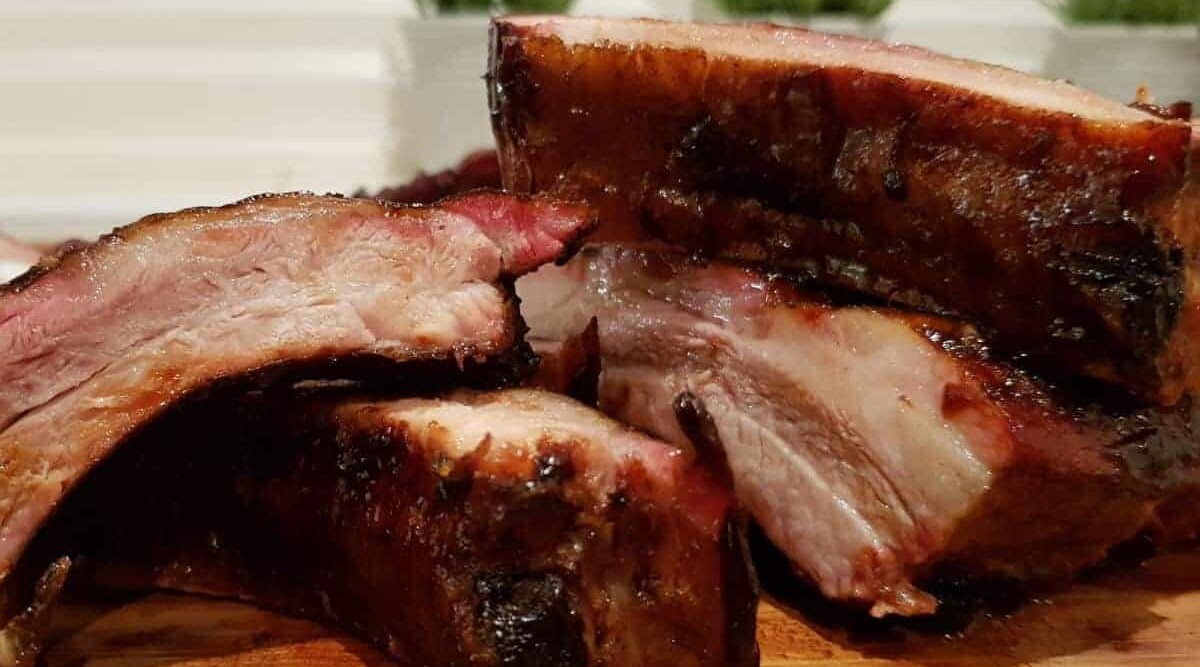
Ribs bring out the inner child in you! There’s no finesse when it comes to enjoying barbecue ribs. Forget about showing up in a white blouse for the occasion. It’s a messy and gooey food that gets millions of people’s faces and hands covered in sticky glaze while they enjoy them.
And the fun part is you get to feel like a kid again. It’s socially acceptable, and no one is going to brand you a slob.
But do you know how long to grill ribs?
Common wisdom says they should be ‘fall off the bone.’ Competition judges want a ‘bit of bite’ left in them, a bit of texture. When you take a bite, they should stay on the bone and not tear away so easily, but should still be tender.
And of course, if you under-cook, they can be tough as old boots.
So there’s a sweet spot to aim for, and in this article we’re going to tell you how to hit it every time.
Jump to:
- 1 If You Don’t Have the Time, Don’t Grill the Ribs
- 2 Selecting Your Rack of Ribs Affects Your Grilling Time
- 3 How Long to Grill Ribs on A Charcoal Grill?
- 4 How Long to Grill Ribs On A Gas Grill?
- 5 Shorten The Time — The Hot and Fast Method
- 6 Understanding the Difference Between “Ready” and “Done”
- 7 3 Tell-Tale Signs That Your Ribs Are Ready
- 8 Tips to Remember About Your Ribs
If You Don’t Have the Time, Don’t Grill the Ribs
Other than grilled cheese sandwiches, quality cooking takes time.
When it comes to ribs, they need time and attention from start to finish. If you don’t watch the temperature, they could be burnt and inedible.
If you don’t cook them long enough, they will be tough and chewy. Don’t treat your family or friends like dogs, growling and gnawing bones to get the meat off.
If you cook them too long, the meat falls off the bone. Remember, we’re not doing pulled pork, people.
You need to prepare the ribs early and give yourself plenty of cooking time. Preparation such as removing the membrane, trimming, rinsing, drying and seasoning are crucial to the finished product, so give yourself enough time.
Next, comes the grilling and smoking time. The temperature and length of cooking time determine whether your ribs are juicy, moist and tender — or burnt, charred and tough.
Knowing how long to grill them and when the meat is ready is the only way to accomplish a quality end result.
I’m going to cover the different times and phases of smoking and grilling tender ribs so that you can be consistently good at it. But before we move on, do you know which type of ribs you’re using?
Selecting Your Rack of Ribs Affects Your Grilling Time
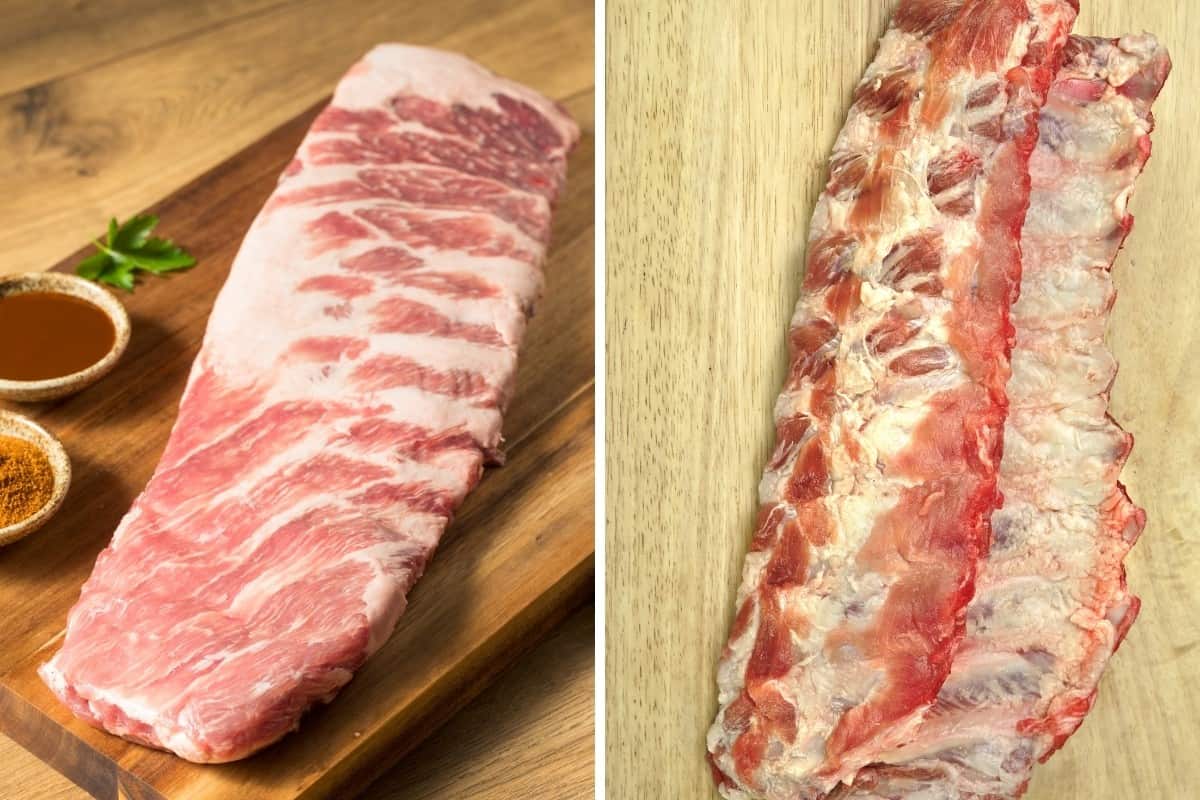
Most of the time when people refer to ribs they’re referring to pork ribs.
Even though there are the popular beef short ribs and even other cuts of beef ribs, as well as lamb ribs, the vast majority of smoked barbecue ribs are pork. And there are three popular types of pork ribs you can buy:
- Baby back ribs
- Spareribs
- Louis-style ribs (trimmed and squared off spareribs.)
Learn how to tell your different pork ribs from each other in this video from the BBQGuys:
Baby backs refer to loin or pork loin back ribs. They are cut from where the rib meets the spine. The upper portion is named baby backs (no they’re not from a baby pig) because they’re shorter compared to spares.
There are about 10 to 13 curved ribs from 3 to 6 inches in length. They’re usually tender and lean.
St. Louis-style and spareribs are cut from the pork belly (minus the belly).
The slab shape is rectangular because the hard breastbone and cartilage are removed. It’s flatter in shape compared to the baby back ribs, and they’re easier to brown because they contain a higher amount of fat.
They’re moist, juicy and very flavorful if cooked properly.
All pork ribs require low and slow cooking, otherwise they’ll be hard and chewy.
Does it make a difference to the cooking time which cut you choose?
Yes, if you cook spares instead of baby backs, you will need to add more cooking time because baby backs are smaller compared to spares.
For example, if you cook both at 225 °F:
- Baby backs — 4 to 5½ hours
- St. Louis-style / spares — 5 to 6½ hours
Here’s more information about the difference between Baby back and St. Louis ribs.
A charcoal grill is your best bet for tasty, tender ribs because of its low and slow cooking process. However, you can still use a gas grill. There is a way around it that I will show you.

“There are two different things: there’s grilling, and there’s barbecue. Grilling is when people say, ‘We’re going to turn up the heat, make it really hot and sear a steak, sear a burger, cook a chicken.’ Barbecue is going low and slow.”
— Guy Fieri, American restaurateur, author, and television personality,
How Long to Grill Ribs on A Charcoal Grill?
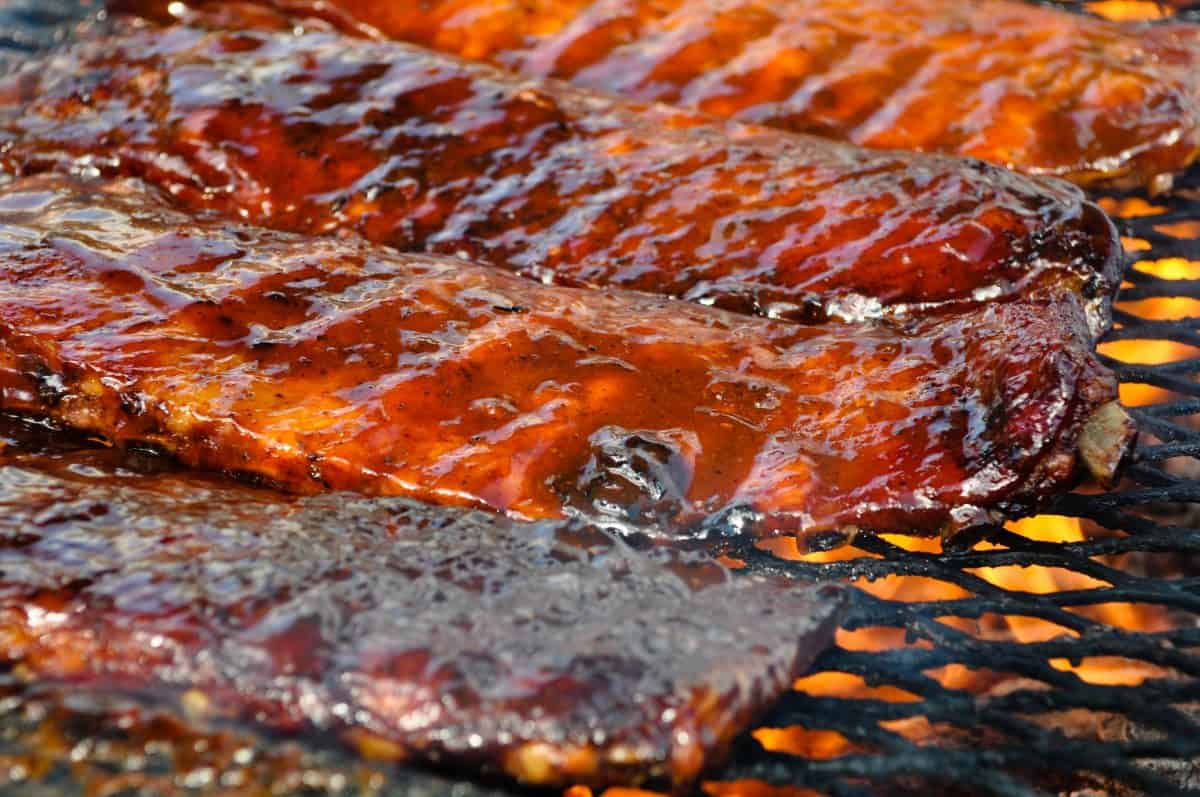
Cooking time depends on grill temperature. The idea is to keep the grill at a consistent temperature of around 225 °F (107 °C).
Low and slow is the name of the game and why you need to give yourself plenty of prep time.
At 225 °F (107 °C), it’s going to take at least 5 hours, possibly just over 6 to cook them.
Although we want the internal temperature of ribs to be 190 °F (88 °C) minimum, it doesn’t mean they’re ready. It takes time to break down the connective tissues that make them tender, and sometimes we need to take them — and slowly — up to as high as 205 °F (96 °C)
The basic timeline looks like this:
- 3 hours of smoking — unwrapped
- 2 hours of cooking — wrapped in foil
- 1 hour of cooking unwrapped at a higher temperature to finish
Your ribs may take more or less time depending on your grill. Remember to occasionally rotate them, check fire, top up your choice of smoking wood for your ribs, and if used your water pan every 30 minutes.
Test for doneness, not time or temp, and you should be ready to serve perfect ribs. I’ll talk about doneness in a moment.
How Long to Grill Ribs On A Gas Grill?
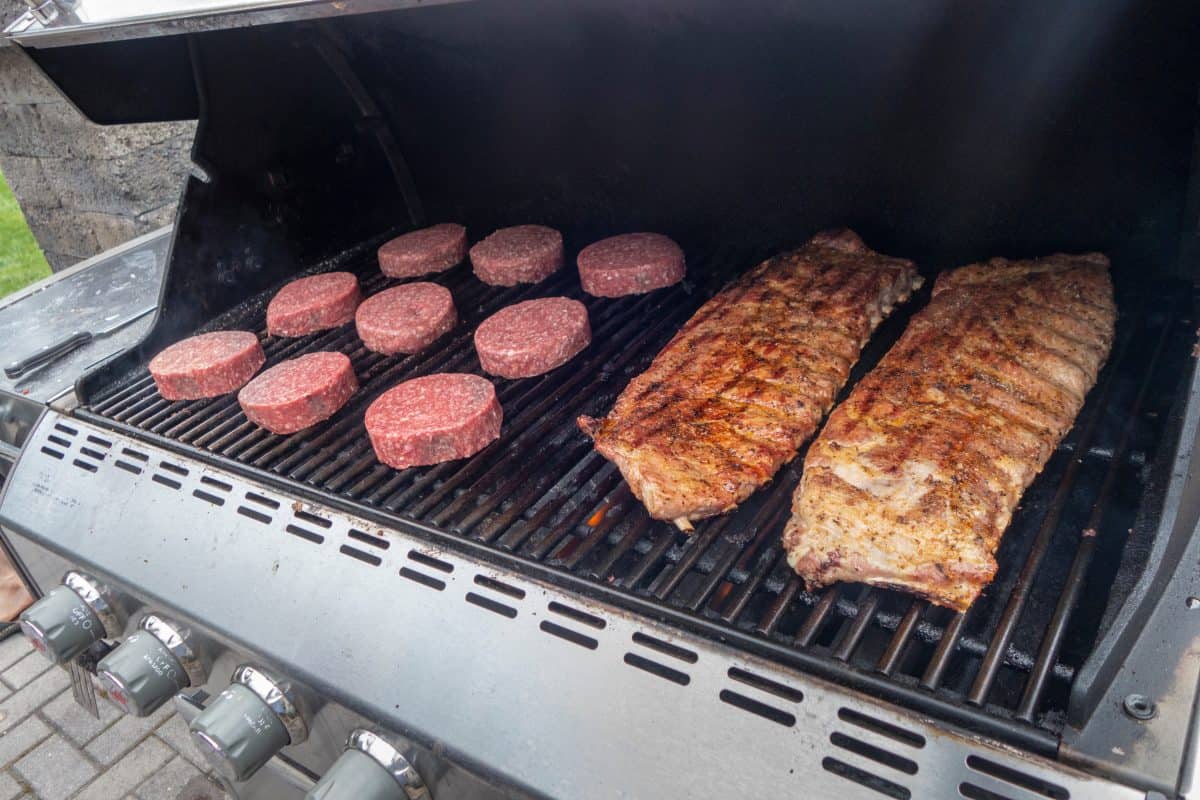
A gas grill is hot and suitable for fast cooking, not so much when it comes to low heat grilling. But, you can do it by making a 2-zone fire by turning off half the burners.
Once you are sure the temperature is steady at 225 °F (107 °C), the cooking times should be the same as the charcoal grill, about 6 hours.
Be sure to rotate the meat and wrap it in foil using the same time guideline as above.
Shorten The Time — The Hot and Fast Method
There is a faster way to cook ribs. Instead of cooking at 225 °F (107 °C), you’ll bump up the temperature to 325 °F (163 °C).
Place your ribs on the top rack (if you have one) and cook unwrapped for 1½ to 2 hours.
After they have a nice deep color, wrap them in foil or butcher paper. The paper method allows some steam to escape, keeping the bark intact and preventing them braising.
Return them to the grill for another 1½ to 2 hours. Check for doneness. Use the last 30 minutes to sauce your ribs and cook on a glaze.
Finally, take them off and let them rest for 15 minutes.
With this method, you can reduce the cooking time by approximately 2 hours, but increase the chances of overcooking and drying out the ribs. Just be diligent about the meat and don’t leave it alone too long.
For a fuller description, recipe and method, see this article from ‘HeyGrillHey.com’
Understanding the Difference Between “Ready” and “Done”
When it comes to good pork ribs there is “ready” and “done.” Just because they’re cooked doesn’t mean they are at their best for eating.
‘Ready’ means that the internal temperature of the meat is a minimum of 145 °F (63 °C), they are cooked and the meat is safe to eat, but you probably won’t like it. The meat will be very tough.
‘Done’ means the ribs have had a chance to gain a higher temperature of around 190 °F to 205 °F (88 °C to 96 °C). Getting to this temp melts the fat and collagens that makes them tough, and instead makes them moist, tender and delicious.
3 Tell-Tale Signs That Your Ribs Are Ready
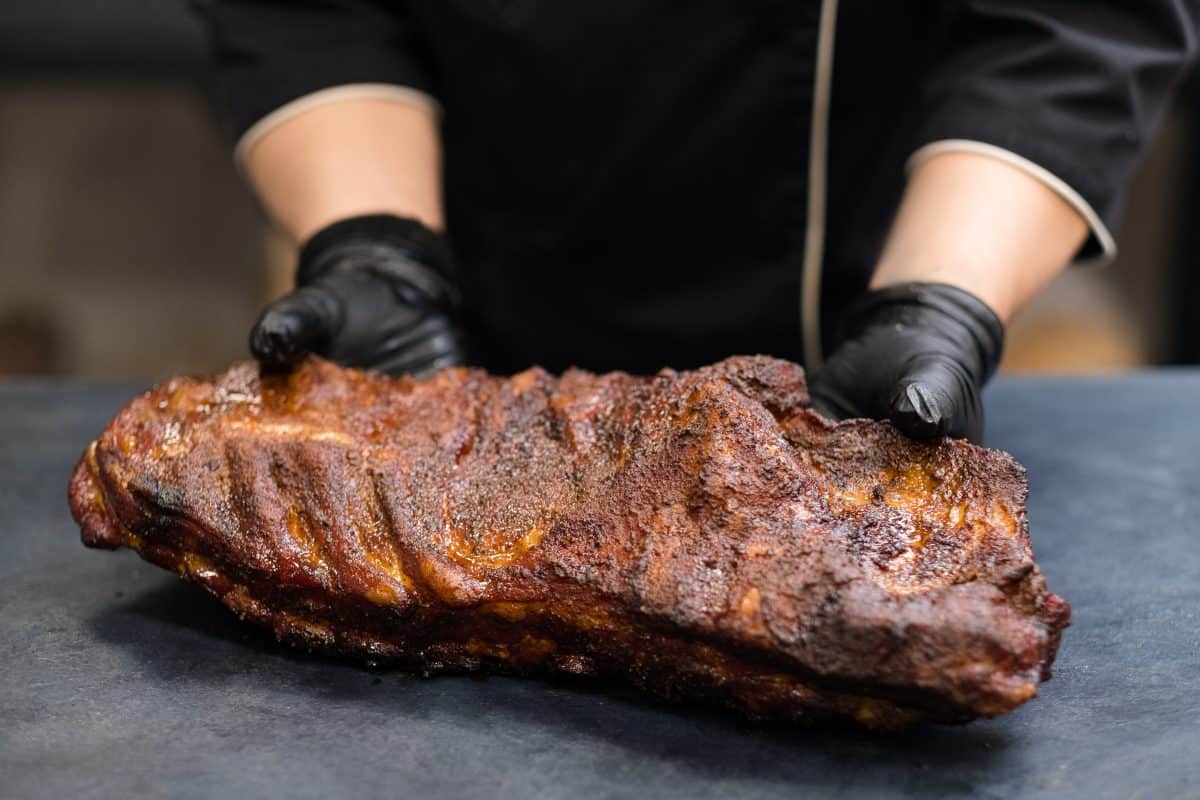
Every time you cook a rack of ribs, there will be slight variances that can change the cooking time. It may be 50 degrees colder from one day to the next, the meat can be thicker or thinner, you keep playing with the dampers and other variables.
Using the 5 to 6 hours cooking time at 225 °F (107 °C) is a good strategy that will produce consistent results. But you still need to check for doneness to be sure. Here are three proven methods to know you’re serving ribs at the peak of their goodness.
The Bend Test
Use your tongs to pick up a slab in the middle. Gently lift it. If you see the meat start to crack and break away from the bone, they’re done. Be careful not to lift too high, or they will break and ruin your slab.
The Toothpick Test
Similar to checking a cake for doneness, this method uses a toothpick. All you do is stick a toothpick into the meat between the bones. If it goes in with no resistance, those ribs are ready! Be sure to check a couple of places in the center and the thickest parts.
The Twist Test
Grip the tip of a bone somewhere near the middle. By giving it a slight twist, you should feel it start to break free of the meat. The collagen and fat have melted, turning into gelatin.
There are a few other methods you can find on the internet. However, we feel these three are the most reliable choices that still leave the meat intact and presentable to your guests.
Tips to Remember About Your Ribs
You’ve probably heard this before, but ribs should not fall off the bone.
When perfectly grilled, they should be tender and moist. You should be able to cleanly bite the meat, or pull it from the bone with your fingers, but the meat should not just fall off. When you take a bite, some meat should stay on the bone.
Ribs that fall off the bone are an indication that they’ve been boiled and steamed, or way overcooked, leaving them with a mushy, flavorless texture.
Here are more pointers to make the best ribs:
- Buy Baby Backs — For the novice chef, try baby backs first. They are fast and easy to cook, tender and well-marbled.
- Remove the Membrane — The membrane is tough and prevents smoke and rubs from seasoning your meat.
- Maintain consistent temperature — Temperature is very important and worth mentioning again. For smoking, stabilize the temperature between 225 °F to 250 °F (105 to 121 °C) and for finishing, browning and sealing in the sauce glaze increase it between 325 °F to 350 °F (163 to 177 °C)
- Add time for sauce — Allow at least 30 minutes near the end of your cooking time. Start by brushing on the barbecue sauce then closing the lid to let the sauce dry. Re-apply every 5 to 8 minutes until you build up that beautiful shiny glaze that is the signature of a perfect rib.
You can’t hurry ribs no matter how hungry you are. Only the ribs can tell you when they’re done. Be patient and use one of the methods we’ve shared above. They’ll be worth the wait.
Happy grilling!


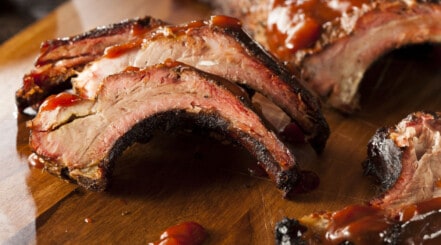
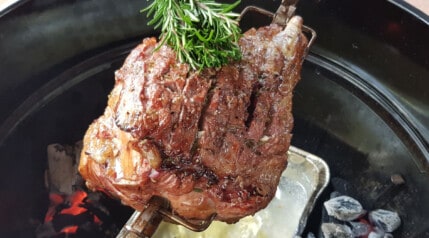

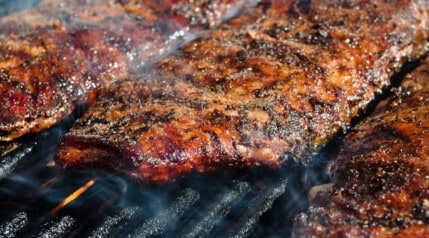
Thank you
Glad you liked it 🙂
Thanks. I am about 3 hours into slow cooking dry rubbed ribs over a gas grill at about 225 °F, smoking and steaming … They look great, I was afraid I was cooking too long. This helped.
Thanks, Bill, that’s good to hear! Best of luck…let us know you get on?
Perfect information, very helpful, just what I was looking for.
No worries, Jim. Glad it helped.
S one like a good method. I like the way you different between some and ready. Lots of tough, underdone ribs out there!
I’ve never wrapped them in foil, I mop with a good, sauce with some oil mixed in. How does wrapping in foil help?
Also, should you turn the ribs over when using indirect heat? I kind of like to because I don’t like the bottom to get dried out.
Hi Mark,
Wrapping the ribs helps blast them through the stall, so they cook quicker and keep them moister as less evaporates during the cook. I don’t tend to turn them over during the cook, no. I keep the bone side toward the heat, (bone side down in my charcoal smokers), which somewhat prevents the meat from drying out too.
Do we boil ribs before cooking
Hi Jim,
There are many recipes on the web that start by boiling ribs, but no…almost nobody ever boils them before smoking low n slow. It’s totally unnecessary, and you lose a lot of the meat flavor.
I never wrap ribs while on the grill but rather right after taking them off. I also keep the sauce separate since I have a lot of people that prefer unsauced
That’s the beauty of cooking, no right or wrong way…only preferences. Memphis style ribs never get wrapped, the method is typically to dry rub, cook straight through and to mop (or spritz) throughout. And they turn out great! They have a slightly firmer ‘bite’ to their texture compared to a Texas crutch (or wrapped) ribs for example, and it’s an end result that many do prefer.
Thanks for this information, it helped a lot.
What if you cut the slab in half? Same amount of time?
Yes, because it’s to do with both thickness of the meat — that will remain the same, just a different length — and having enough time at a low temp to soften and melt the connective tissues until they are tender.
I have enjoyed the lessons on cooking ribs and making sure that the fire temperature is correct.
Thanks